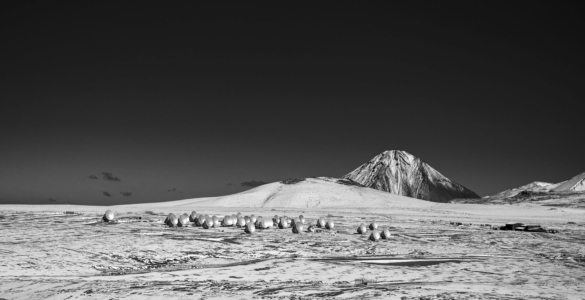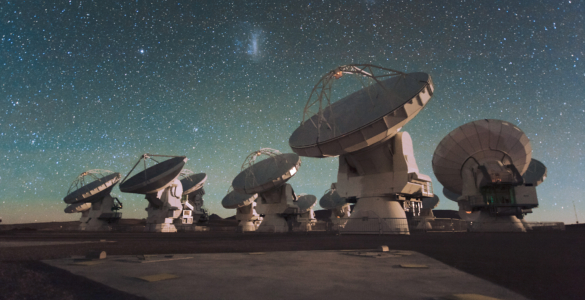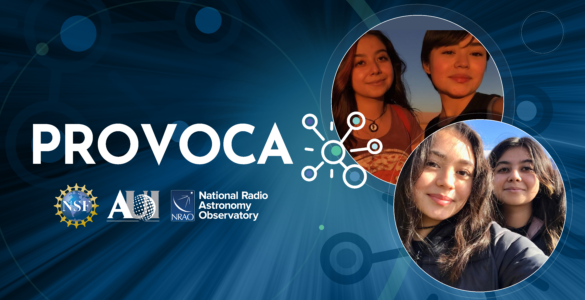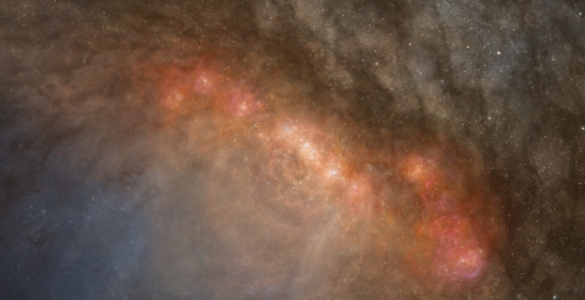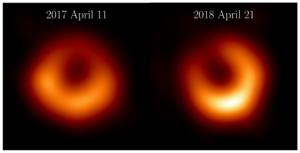
The Event Horizon Telescope (EHT) Collaboration has released new images of supermassive black hole M87*. A recent paper published in the journal Astronomy & Astrophysics presents new images from data collected by the Atacama Large Millimeter/submillimeter Array (ALMA) and several other instruments within the EHT. These new images show a bright ring surrounding a deep central depression, “the shadow of the black hole,” as predicted by general relativity. Excitingly, the brightness peak of the ring has shifted by about 30º compared to the first images, which is consistent with scientists’ theoretical understanding of variability from turbulent material around black holes.
“A fundamental requirement of science is to be able to reproduce results,” says Dr. Keiichi Asada, an associate research fellow at Academia Sinica Institute for Astronomy and Astrophysics in Taiwan. “Confirmation of the ring in a completely new data set is a huge milestone for our collaboration and a strong indication that we are looking at a black hole shadow and the material orbiting around it.”
The image of M87* taken in 2018 is remarkably similar to what was seen in 2017—a bright ring of the same size, with a dark central region and one side of the ring brighter than the other. The mass and distance of M87* will not appreciably increase throughout a human lifetime, so general relativity predicts that the ring diameter should stay the same from year to year.
To help accomplish new and exciting science, the EHT is under continuous development. The Greenland Telescope joined the EHT for the first time in 2018, just five months after its construction was completed far above the Arctic Circle. This new telescope significantly improved the image fidelity of the EHT array, improving the coverage, particularly in the North-South direction. The Large Millimeter Telescope also participated for the first time with its full 50 m surface, greatly improving its sensitivity. With the use of the phased-up ALMA array of twenty 12-m diameter antennas, also observed in the 2017 experiments, the 2018 EHT array had significantly improved sensitivity and u-v coverage to produce a high quality image. The EHT array was also upgraded to observe in four frequency bands around 230 GHz, compared to only two bands in 2017.
Repeated observations with an improved array are essential to demonstrate the robustness of findings and strengthen confidence in results. In addition to the groundbreaking science, the EHT also serves as a technology testbed for cutting-edge developments in high-frequency radio interferometry.
The image of M87* taken in 2018 is remarkably similar to what was observed in 2017. Astronomers saw a bright ring of the same size, with a dark central region and one side of the ring brighter than the other. The mass and distance of M87* will not appreciably increase throughout a human lifetime, so general relativity predicts that the ring diameter should stay the same from year to year. The stability of the measured diameter in the images from 2017 to 2018 robustly supports the conclusion that M87* is well described by general relativity.
“One of the remarkable properties of a black hole is that its radius is strongly dependent on only one quantity: its mass,” said Dr. Nitika Yadlapalli Yurk, a former graduate student at the California Institute of Technology (Caltech), now a postdoctoral fellow at the Jet Propulsion Laboratory in California. “Since M87* is not accreting material (which would increase its mass) at a rapid rate, general relativity tells us that its radius will remain fairly unchanged over human history. It’s pretty exciting to see that our data confirm this prediction.”
This work used data from ALMA and seven other instruments across the EHT array, including the Atacama Pathfinder EXperiment (APEX), the IRAM 30-meter telescope (PV), the James Clerk Maxwell Telescope (JCMT), the Large Millimeter Telescope (LMT), the Submillimeter Array (SMA), the Submillimeter Telescope (SMT), and the Greenland Telescope (GLT).
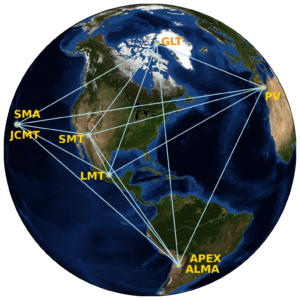
Portions of this release were taken from news shared by the Event Horizon Telescope and the Joint ALMA Observatory.
Read EHT’s complete press release here.
Read JAO’s complete press release here.
About the EHT
The EHT collaboration involves more than 300 researchers from Africa, Asia, Europe, and North and South America. The international collaboration is working to capture the most detailed black hole images ever obtained by creating a virtual Earth-sized telescope. Supported by considerable international investment, the EHT links existing telescopes using novel systems, creating a fundamentally new instrument with the highest angular resolving power that has yet been achieved.
The individual telescopes involved are ALMA, APEX, the IRAM 30-meter Telescope, the IRAM NOEMA Observatory, the James Clerk Maxwell Telescope (JCMT), the Large Millimeter Telescope (LMT), the Submillimeter Array (SMA), the Submillimeter Telescope (SMT), the South Pole Telescope (SPT), the Kitt Peak Telescope, and the Greenland Telescope (GLT). Data were correlated at the Max-Planck-Institut für Radioastronomie (MPIfR) and MIT Haystack Observatory. The postprocessing was done within the collaboration by an international team at different institutions.
The EHT consortium consists of 13 stakeholder institutes: the Academia Sinica Institute of Astronomy and Astrophysics, the University of Arizona, the University of Chicago, the East Asian Observatory, Goethe-Universitaet Frankfurt, Institut de Radioastronomie Millimétrique, Large Millimeter Telescope, Max Planck Institute for Radio Astronomy, MIT Haystack Observatory, National Astronomical Observatory of Japan, Perimeter Institute for Theoretical Physics, Radboud University, and the Smithsonian Astrophysical Observatory.
About ALMA & NRAO
The Atacama Large Millimeter/submillimeter Array (ALMA), an international astronomy facility, is a partnership of the European Organisation for Astronomical Research in the Southern Hemisphere (ESO), the U.S. National Science Foundation (NSF) and the National Institutes of Natural Sciences (NINS) of Japan in cooperation with the Republic of Chile. ALMA is funded by ESO on behalf of its Member States, by NSF in cooperation with the National Research Council of Canada (NRC) and the Ministry of Science and Technology (MOST) and by NINS in cooperation with the Academia Sinica (AS) in Taiwan and the Korea Astronomy and Space Science Institute (KASI).
ALMA construction and operations are led by ESO on behalf of its Member States; by the National Radio Astronomy Observatory (NRAO), managed by Associated Universities, Inc. (AUI), on behalf of North America; and by the National Astronomical Observatory of Japan (NAOJ) on behalf of East Asia. The Joint ALMA Observatory (JAO) provides the unified leadership and management of the construction, commissioning and operation of ALMA.
NRAO is a facility of the National Science Foundation, operated under cooperative agreement by Associated Universities, Inc.











